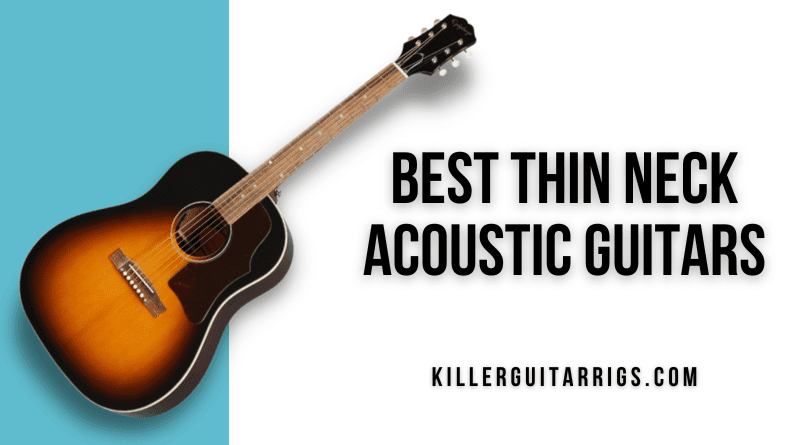Thin-neck guitars are preferred by many players, since they offer more comfort and the ability to move faster about the neck. In theory, the thinner neck allows a player to more easily go from Point A to B.
Naturally, this depends on the player. Many swear by the grip and feel provided by regular or thick necks. Preferences aside, thin-neck guitars have proliferated in the past few years, and they are now a common feature on all types of guitars, from acoustics to electrics and even nylon-stringed instruments.
Perhaps the thin- vs regular-neck debate will grow like Gibson vs Fender, etc. In any case, companies have responded to the heightened demand for thin-neck guitars. There are countless models available on the market today, and they can be quite varied.
With so many choices out there, how do you make sense of it all? We’re here to help you pick the best thin-neck guitar for you. Read on.
Read more about our review process.
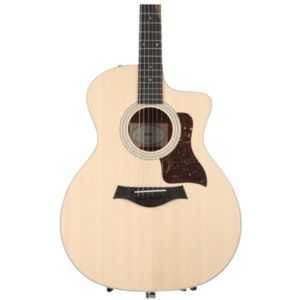
Taylor 214ce
Features: Solid Sitka spruce top, Slender neck, Quality gig bag
Benefits: Big bright tones, Responsive feel, Superb build quality
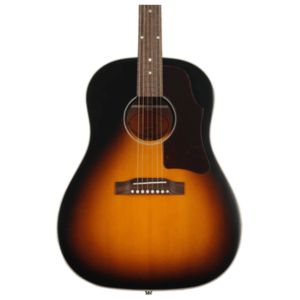
Epiphone J-45
Features: SlimTaper Neck Profile, Solid Sitka spruce top, Fishman electronics
Benefits: Affordable Gibson alternative, Fast playing, Organic amplified tones
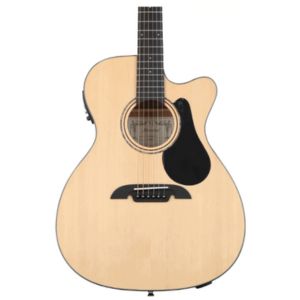
Alvarez AF30CE Artist 30
Features: Venetian cutaway, Solid Sitka spruce top, Hybrid V to C neck
Benefits: Forgiving playability, Big voice, Excellent upper fret access
Contents
Our Top 3
The Epiphone J45 is our Top Pick. This is a recreation of Gibson’s legendary J45 guitar, at an affordable price. It features a solid Sitka spruce top as well as a solid mahogany back and sides for resonant and projecting sound with tons of warmth.
The Alvarez AF30CE Artist 30 Folk is our Best Budget guitar for this list. It’s designed with a focus on comfortable playing, delivering a nice tone at a low price. An ideal choice for beginners and students.
Finally, the Taylor 214ce is our Editor’s Choice. With a Grand Auditorium body shape and the width and depth of a dreadnought, this guitar excels in tone and playability and is a great choice for dedicated pros.
Individual Reviews

Epiphone J45
The recreation of a legendary guitar.
This Epiphone was inspired by the legendary Gibson J-45 acoustic guitar. Under the umbrella of Gibson, Epiphone makes more affordable versions of some of Gibson's most renowned instruments. In this particular case, the original J-45 is believed by many to be the paradigm for the dreadnought guitar.
The Epiphone J45 features a solid Sitka spruce top as well as a solid mahogany back and sides. This guitar comes with a nut width of 1.693″ and also looks the part, with an aged-gloss finish and dark brown fade on the top.
We liked how responsive the Indian laurel fingerboard was, particularly to our fingerstyle playing. The mahogany neck felt very comfortable, with a consistent grip throughout. With a rounded “C” profile and a typical Gibson 24-3/4-inch scale, this guitar was a joy to play, especially for strumming chords or songwriting.
The tone on the Epiphone J-45 was warm and the instrument had a nice overall projection. In addition to fingerpicking, the sound of this guitar is a good choice for folk, country, and even soft rock. Naturally, a guitar with such features makes a perfect option for songwriters.
If you’d like to perform your songs live, the J45 comes with a Fishman Sonicore pickup. We tried this guitar plugged into our Roland JC-120 and its acoustic sound translated well, warmth included.
We also liked the amount of control we had when plugged in. The Fishman Presys II preamp comes with controls for Volume, Bass, and Treble. You also get a phase switch and a built-in tuner to complete the package.
Additional features like a tortoise-shell pickguard and ivory binding round out the Epiphone J-45. In short, a fantastic acoustic guitar that delivers a nice tone and playability with an unmistakable Gibson flavor.
Verdict: The Epiphone J45 provides a warm tone with nice overall projection and is quite comfortable to play. This guitar also allows you to plug into a PA or amp thanks to its Fishman Presys II preamp that delivers great quality when plugged in.
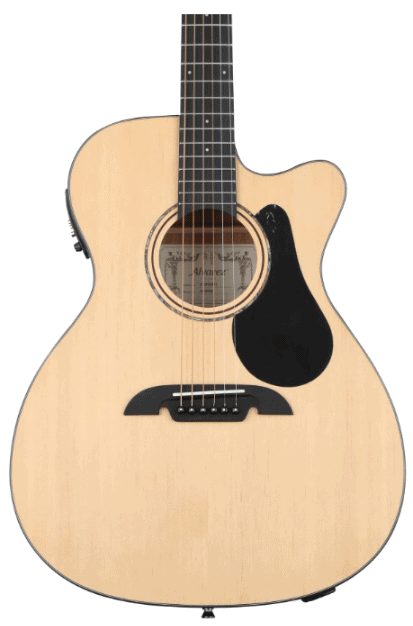
Alvarez AF30CE Artist 30 Folk
Features and tone that suggest a pricier instrument.
This guitar belongs to Alvarez’s artist series, and comes with a focus on comfortable playing with a nice tone at a low price. This instrument is a great choice for beginners and students that want to maximize their dollars.
The Alvarez Artist 30CE Folk acoustic guitar features a slim, tapered OM-style body, as well as a solid top built from Sitka spruce. This guitar was designed with a sapele back and sides to complement its top.
We strummed a few chords and got a warmth and sustain that seemed to belong to a pricier guitar. However, the Alvarez Artist 30CE Folk is truly affordable and will be a great choice for students and singer/songwriters.
Alvarez did a great job with the tonewoods selected. The Sapele back and sides, and Sitka top delivered a resonant tone with great projection. This was impressive considering the low price of this instrument.
The Artist 30CE was also comfortable to play with a nut width of 1.75″, and we liked the feel of its hardwood mahogany neck along the 21 frets and Techwood fretboard. This neck comes with a hybrid soft “V” to “C” shape that remained comfortable as we went up on the higher frets.
Other features that also suggest a pricier guitar include chrome Alvarez tuning machines, a bone nut and saddle, spruce bracing, and built-in Alvarez SYS250 electronics.
Plugging this Alvarez into our Roland amp to test out the electronics, we got straightforward acoustic amplification that did a good job of translating the round acoustic tone of this instrument.
We also liked that this preamp system comes with a volume knob, a presence slider, and a 3-band EQ for dialing in bass, mids, and treble frequency. There is also a built-in tuner that glows in the dark.
Verdict: The Alvarez Artist 30CE Folk acoustic guitar gives you a nice present tone that projects well, with a comfortable mahogany neck. With a built-in Alvarez preamp for acoustic amplification, this guitar’s price and features make it an ideal choice for beginners.
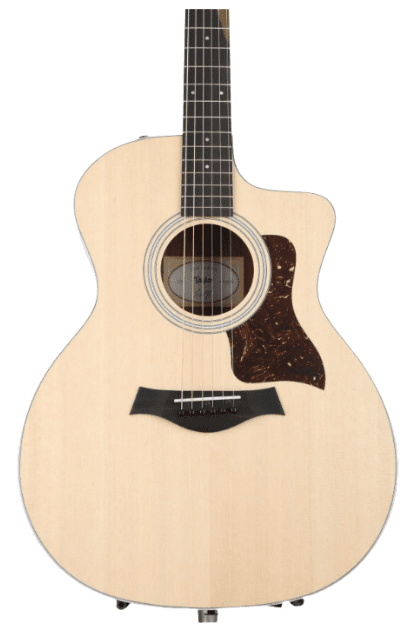
Taylor 214ce
Fantastic quality with added comfort.
Taylor is among the top brands for acoustic guitars as they have been producing top-notch instruments for decades. The 214ce is no exception and is a great choice for dedicated professionals looking for a superior thin line neck acoustic.
The Taylor 214ce features a Grand Auditorium body shape, with the width/depth of a dreadnought and a 1.6875″ nut width. Interestingly, its tapered-waist design makes it look like a smaller guitar.
We started our tests by strumming some open chords with a pick. The sound of this Taylor was balanced with a nice presence that filled our room. We loved the Sitka spruce top in combination with the Indian rosewood sides and back. Together, this choice of tonewoods resulted in a sound that displays an ample frequency range with a rich tone.
We got crisp articulation that works well for multiple playing styles. Both our fingerpicking and forceful flat-picked strumming came through with great detail.
The playability on this Taylor is second to none. We loved the feel of the Tropical mahogany neck and the responsiveness of the West African ebony fingerboard. With a 15″ radius, this guitar was quite comfortable and the neck was as smooth as they come.
The 214cd also comes with built-in ES2 electronics, which delivered that same balanced tone when plugged into our Roland JC-120 amp. In typical Taylor fashion, the electronics are controlled by three very discreet, unmarked and elegant knobs on the top side of the instrument.
In short, a thin-line guitar that excels in tone, playability, and overall features. This guitar is a great option for the player who values quality and tone and who is willing to pay the price for a superior instrument.
Verdict: The Taylor 214ce comes with a Grand Auditorium body shape and the width and depth of a dreadnought. This thin-line guitar offers superior tone and playability and features classic Taylor quality in its construction and design, making it a great choice for professionals.
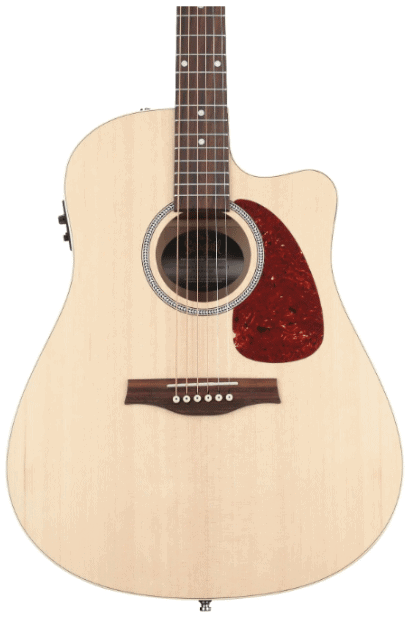
Seagull Guitars Coastline S6 Slim
Detailed tone with selected tonewoods from Canada.
Seagull has crafted guitars that come with great attention to detail and quality tonewoods for over a quarter century. Handcrafted in a tiny village east of Quebec, this guitar provides you with a full tone on a smaller body.
The Seagull Coastline S6 Slim features a slightly shorter nut than the original Seagull S6, resulting in tighter string spacing that delivers a more traditional neck feel. With a modified dreadnought body shape, the Coastline S6 Slim features a single cutaway for greater comfort to reach the high frets.
This guitar gave us a bright and resonant tone, thanks to its spruce top. This choice of tonewood provides a more responsive and louder playing experience than Seagull’s standard cedar tops. The spruce top also made a difference in the stronger punch and top-end response this guitar gave us.
Said response and tone were enhanced by the wild-cherry laminate that Godin used for the back and sides. This combination of tonewoods can rival the sonic traits of mahogany and maple at a lower price.
For plugged-in performance, this Seagull comes with a Fishman Presys II pickup system. This system did a good job of capturing its acoustic tone when plugged into our Roland amp. However, we did wish it came with a 3-band EQ instead of its 2-band EQ, which offer fewer tone-control options for various playing environments.
This Seagull acoustic guitar provided us with a comfortable playing experience, with a nut width of 1.72″. Everything from open and barre chords all the way to bluesy licks felt great on its signature “D” maple-neck profile. We also loved the rosewood fingerboard and 25.5-inch scale length, which added familiarity to the guitar’s feel.
Verdict: The Seagull Coastline S6 Slim comes in a modified dreadnought body shape, and select Canadian tonewoods that produce a bright and loud sound. With a Fishman pickup system, this guitar is great for songwriters as well as performers who play folk, bluegrass, or any other genre where the song is key.
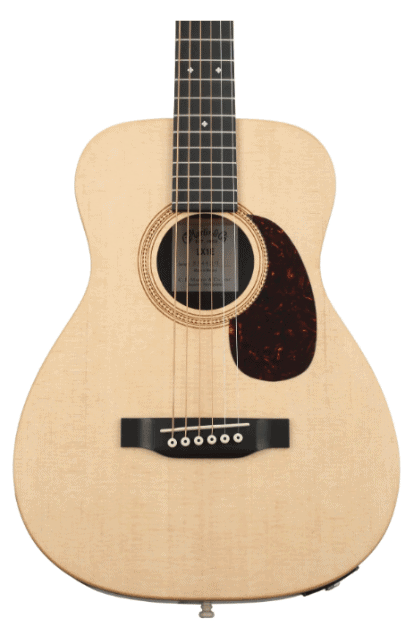
Martin LX1RE Little Martin
Huge tone on a smaller body.
This is a smaller guitar that is in line with Martin's tradition of innovation as well as quality construction. Built with sustainable materials, the LX1RE has a bigger tone than its petite body suggests, and it with a very affordable price tag.
The Martin LX1RE Little Martin features a solid sitka spruce top and rosewood-patterned HPL back and sides. From the first chord we played, we got a warm and emphatic sound that surprised us for a smaller guitar. Martin dubs this size a modified 0-14 body, and comes with a body length of 17-13/16″.
The body on this instrument may seem tiny in comparison to other acoustics, but the playing experience was undoubtedly Martin. From the warm and projecting sound to the playability and even the looks, Martin managed to infuse their true identity into this smaller and more affordable instrument.
Speaking of playability, the Little Martin comes with a rust birch laminate neck, with a modified low oval neck shape that feels comfortable. With a radius of 16″, this guitar also features an FSC-certified Richlite fretboard and bridge.
This tonewood felt good and is also sustainable. Martin has been paying great attention to environmental issues when building their guitars. Besides, Richlite isn’t easily affected by temperature and humidity changes, which is a massive plus for any acoustic guitar.
This guitar comes with Fishman Sonitone electronics for plugging in. We tried this going into our Marshall acoustic guitar amp and got a decent tone. The controls are located on the upper side of the soundhole and feel a bit limited as there is only a volume and a single tone knob.
Verdict: The Martin LX1RE Little Martin features a smaller body that delivers a warm and emphatic sound. With features like a modified 0-14 body, Fishman Sonitone electronics, and quality tonewoods for the top, back, and sides, this Little Martin is a great choice for students and folks who prefer a smaller guitar that delivers great quality.
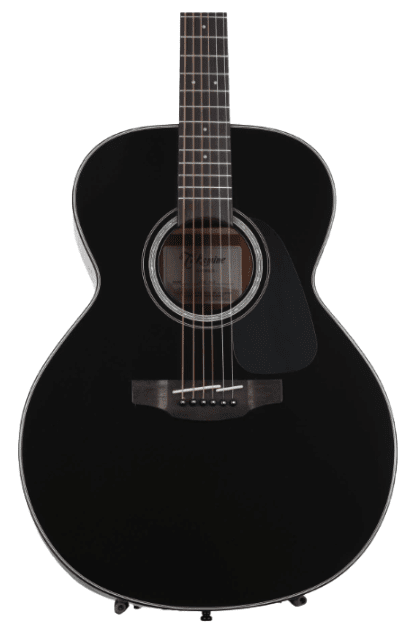
Takamine GN30
A smaller jumbo guitar that plays and sounds killer.
This company's history goes back to 1962. Since then, Takamine has built countless acoustic guitars that deliver a great balance between quality and price, making them very popular. The GN30 is no exception and delivers a nice tone with the added comfort of a smaller instrument.
The Takamine GN30 is a smaller jumbo-type acoustic guitar which features a solid spruce top and mahogany back and sides. This tonewood combination is one of the most common and beloved, as it produces great tones and is not too expensive.
We started playing this Takamine acoustic with a pick, going from soft understated strums to more forceful playing. This small jumbo gave us a rich and balanced tone that is ideal for songwriters and folks who gravitate toward acoustic pop and acoustic rock.
We also liked how this guitar sounded when we played a bit of fingerstyle, with the tone having that warmth that we’ve come to associate with the combination of spruce top and mahogany back and sides.
This guitar was also comfortable, which will be particularly helpful to folks with smaller arms. With a smaller jumbo body, this Takamine makes it easier to position yourself to play, especially when compared to the regular jumbo body that’s just too big for some people.
With a mahogany neck and a radius of 12″, this guitar was relatively comfortable to play. We really liked the rosewood fingerboard, as it gave us a nice response to our playing subtleties and also provided a familiar feeling.
This Takamine stayed in tune and had good intonation as well, in part thanks to the split-saddle design that allows the string to angle just right to maximize vibration and stability. This guitar’s stability remained consistent even in the higher frets, making it a good choice for folks who enjoy a bit of soloing.
In short, a solid guitar that offers a warm tone and nice playability. We just wished it had an electronic system that would allow us to plug it in and perform.
Verdict: The Takamine GN30 features a smaller jumbo design and is built with a common tonewood combination of solid spruce top and mahogany back and sides. This guitar produces a warm tone and is more comfortable than a regular jumbo, given its reduced size.
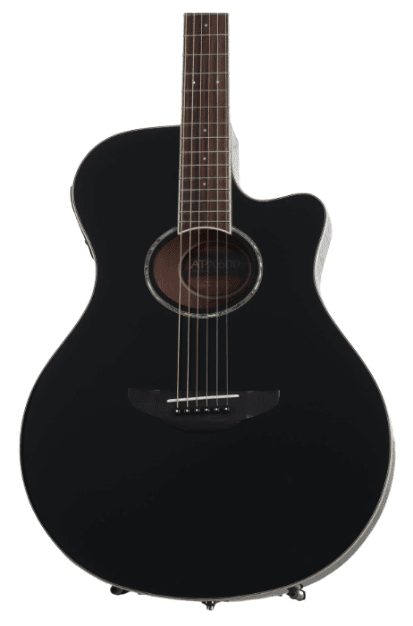
Yamaha APX600 Thin-line Cutaway
A good choice for beginners that want Yamaha quality.
Yamaha is renowned for offering quality instruments for over half a century. This guitar delivers nice craftsmanship as well as affordability, in an instrument that sounds as good as it plays.
The Yamaha APX600 Thinline Cutaway is an acoustic-electric featuring a spruce top, a nut width of 1.6875″, and a stylized body with a slick overall look. This guitar gave us a forward tone that was rich in the mids and loud enough to fill our room.
We found this guitar comfortable to play and we think it will serve beginners well. One of our favorite features was the rosewood fingerboard, which gave us a nice response when we played fingerstyle, as well as with several strumming patterns using a pick.
Yamaha also included a piezo pickup system, so you can plug it into an amp or PA system. We tried it via our Roland JC-120 and got a good representation of the forward acoustic tone on this guitar. This system comes with a 3-band EQ and onboard tuner, making it very convenient for coffee-shop gigs or jam sessions.
This guitar is a good choice for beginners and students alike, due to its affordable price and because of Yamaha’s Player Port app. This app can be installed on iOS and Android devices, providing a variety of tips, tricks, advice, videos, etc. It is specifically designed for those who are starting out on the instrument and it includes a built-in tuner.
In short, a good guitar for folks who are just starting out, with the quality we’ve come to expect from Yamaha.
Verdict: The Yamaha APX600 Thinline Cutaway features a spruce top for nice resonance and a comfortable body with a slick overall look. This guitar is a nice choice for beginners, as it produces a good tone and comes with built-in electronics and Yamaha’s Player Port app where you can register your instrument and find plenty of resources for learning.
How to Choose the Right Model for You
A thin-neck guitar usually features a nut width of less than 1.9”. Many players opt for these slim necks because they can greatly ease playability, making complicated or fast parts more manageable.
Below are some guidelines on what to look for when considering a thin-line guitar for purchase.
Sound and Tonewoods
These are paramount considerations for any guitar, and thin necks are no exception. The type of wood used is largely responsible for the kind of sound and projection that your guitar features. For instance, guitars with the common combination of spruce on the top and mahogany on the back and sides tend to offer great resonance and a nice volume.
If mahogany is used on the top instead, the sound becomes more punchy with low overtones and a nice high-end response. Another choice for top wood is maple, which produces heavier and more transparent tonal qualities.
None of the woods mentioned above are as economical and lightweight as poplar, but the tradeoff is that you get a guitar with less sustain.
Body Type
Common body types include Dreadnoughts, Grand Concerts, and Grand Auditoriums. Many thin-neck guitars offer variations on these body types, often making them smaller to further increase player comfort. However, it is important to understand what each of these bodies provides.
Dreadnought bodies produce deep lows and clear highs and are known to provide a balanced representation of frequencies. Although dreadnoughts are great for nice articulation, they can be a bit boomy, making your low end less clear.
Grand Concerts are also popular, and smaller than dreadnoughts. Because of their reduced size, they are not as loud but offer a nice bump on the middle frequencies.
Grand Auditorium guitars give you a bit of both worlds, falling somewhere between a Dreadnought and a Grand Concert in size. They provide clear sound and great definition and are popular among fingerstyle musicians.
Electronics
Many thin-neck guitars come outfitted with electronics in order to plug into an amp or PA. This allows you to play live in front of people or even with a band. Naturally, not everyone looking into a thin-neck guitar needs a preamp, pickup, or piezo to amplify their acoustic sound.
It’s important to ask yourself what you want the guitar for. For instance, if you just want a guitar to learn on, electronics are not a necessity. On the other hand, if you are a songwriter interested in showcasing your songs on open mics, then consider buying a thin-neck guitar with electronics that allow you to plug in.
Keep in mind that electronics increase the price of the guitar, usually in a significant way.
Price
In general, better-sounding guitars which feature superior playability and tonewoods usually cost more than cheap guitars. Again, asking yourself what you need the guitar for is key.
Keep in mind, many affordable guitars are perfectly fine for beginners interested in learning and even for songwriters. In other words, you don’t need to spend much to get a decent instrument.
Final Thoughts
Thin-neck guitars have become quite common, with most guitar companies now offering several models. They are particularly popular among players with smaller hands, and can provide greater comfort and range of motion.
Thin-neck guitars tend to be especially good for beginners, as their easy playability makes it easier to make chords sound good. However, it is imperative that you try the guitar and see if its neck feels right for you before making a decision.
To recap our choices, the Epiphone J45 is our Top Pick. This is a recreation of Gibson’s legendary J45 guitar, at an affordable price. It features a solid Sitka spruce and a solid mahogany back and sides for resonant and projecting sound with tons of warmth.
The Alvarez AF30CE Artist 30 Folk is our Best Budget selection. It’s designed with a focus on comfortable playing, delivering a nice tone at a low price. An ideal choice for beginners and students alike.
Finally, the Taylor 214ce is our Editor’s Choice. With a Grand Auditorium body shape and the width and depth of a dreadnought, this guitar excels in tone and playability and is a great choice for dedicated pros.

